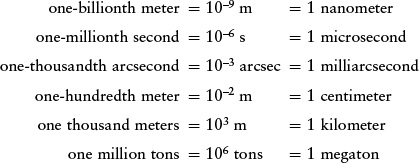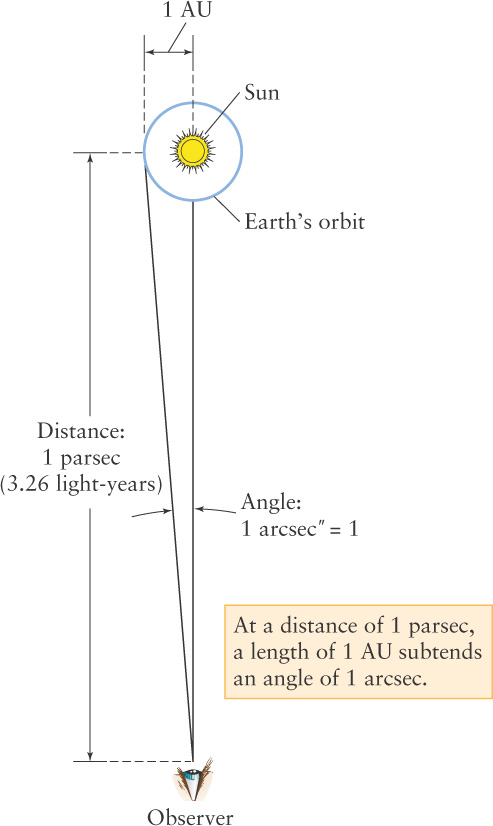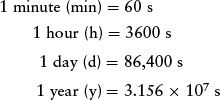1-7 Astronomical distances are often measured in astronomical units, light-years, or parsecs
Specialized units make it easier to comprehend immense cosmic distances
Astronomers use many of the same units of measurement as do other scientists. They often measure lengths in meters (abbreviated m), masses in kilograms (kg), and time in seconds (s). (You can read more about these units of measurement, as well as techniques for converting between different sets of units, in Box 1-3.)
Like other scientists, astronomers often find it useful to combine these units with powers of ten and create new units using prefixes. As an example, the number 1000 (= 103) is represented by the prefix “kilo,” and so a distance of 1000 meters is the same as 1 kilometer (1 km). Here are some of the most common prefixes, with examples of how they are used:

In principle, we could express all sizes and distances in astronomy using units based on the meter. Indeed, we will use kilometers to give the diameters of Earth and the Moon, as well as the Earth-Moon distance. But, while a kilometer (roughly equal to three-fifths of a mile) is an easy distance for humans to visualize, a megameter (106 m) is not. For this reason, astronomers have devised units of measurement that are more appropriate for the tremendous distances between the planets and the far greater distances between the stars.
When discussing distances across the solar system, astronomers use a unit of length called the astronomical unit (abbreviated AU). This is the average distance between Earth and the Sun:
1 AU = 1.496 × 108 km = 92.96 million miles
Thus, the average distance between the Sun and Jupiter can be conveniently stated as 5.2 AU.
 To talk about distances to the stars, astronomers use two different units of length. The light-year (abbreviated ly) is the distance that light travels in one year. This is a useful concept because the speed of light in empty space always has the same value, 3.00 × 105 km/s (kilometers per second) or 1.86 × 105 mi/s (miles per second). In terms of kilometers or astronomical units, one light-year is given by
To talk about distances to the stars, astronomers use two different units of length. The light-year (abbreviated ly) is the distance that light travels in one year. This is a useful concept because the speed of light in empty space always has the same value, 3.00 × 105 km/s (kilometers per second) or 1.86 × 105 mi/s (miles per second). In terms of kilometers or astronomical units, one light-year is given by
1 ly = 9.46 × 1012 km = 63,240 AU
This distance is roughly equal to 6 trillion miles.
13
CAUTION!
Keep in mind that despite its name, the light-year is a unit of distance and not a unit of time. As an example, Proxima Centauri, the nearest star other than the Sun, is a distance of 4.2 light-years from Earth. This means that light takes 4.2 years to travel to us from Proxima Centauri.
Physicists often measure interstellar distances in light-years because the speed of light is one of nature’s most important numbers. But many astronomers prefer to use another unit of length, the parsec, because its definition is closely related to a method of measuring distances to the stars.
Imagine taking a journey far into space, beyond the orbits of the outer planets. As you look back toward the Sun, Earth’s orbit subtends, or extends over, a smaller angle in the sky the farther you are from the Sun. As Figure 1-14 shows, the distance at which 1 AU subtends an angle of 1 arcsec is defined as 1 parsec (abbreviated pc):
1 pc = 3.09 × 1013 km = 3.26 ly

TOOLS OF THE ASTRONOMER’S TRADE
Units of Length, Time, and Mass
To understand and appreciate the universe, we need to describe phenomena not only on the large scales of galaxies but also on the submicroscopic scale of the atom. Astronomers generally use units that are best suited to the topic at hand. For example, interstellar distances are conveniently expressed in either light-years or parsecs, whereas the diameters of the planets are more comfortably presented in kilometers.
Most scientists prefer to use a version of the metric system called the International System of Units, abbreviated SI (after the French name Système International). In SI units, length is measured in meters (m), time is measured in seconds (s), and mass (a measure of the amount of material in an object) is measured in kilograms (kg). How are these basic units related to other measures?
When discussing objects on a human scale, sizes and distances can also be expressed in millimeters (mm), centimeters (cm), and kilometers (km). These units of length are related to the meter as follows:

A useful set of conversions for the English system is

Each of these equalities can also be written as a fraction equal to 1. For example, you can write

Fractions like this are useful for converting a quantity from one set of units to another. For example, the Saturn V rocket used to send astronauts to the Moon stands about 363 ft tall. How can we convert this height to meters? The trick is to remember that a quantity does not change if you multiply it by 1. Expressing the number 1 by the fraction (0.3048 m)/(1 ft), we can write the height of the rocket as

14
EXAMPLE: The diameter of Mars is 6794 km. Let’s try expressing this in miles.
CAUTION!
You can get into trouble if you are careless in applying the trick of taking the number whose units are to be converted and multiplying it by 1. For example, if we multiply the diameter by 1 expressed as (1.609 km)/(1 mi), we get

The unwanted units of km did not cancel, so this answer cannot be right. Furthermore, a mile is larger than a kilometer, so the diameter expressed in miles should be a smaller number than when expressed in kilometers.
The correct approach is to write the number 1 so that the unwanted units will cancel. The number we are starting with is in kilometers, so we must write the number 1 with kilometers in the denominator (“downstairs” in the fraction). Thus, we express 1 as (1 mi)/(1.609 km):

Now the units of km cancel as they should, and the distance in miles is a smaller number than in kilometers (as it must be).
When discussing very small distances such as the size of an atom, astronomers often use the micrometer (µm) or the nanometer (nm). These are related to the meter as follows:

Thus, 1 µm = 103 nm. (Note that the micrometer is often called the micron.)
The basic unit of time is the second (s). It is related to other units of time as follows:

In the SI system, speed is properly measured in meters per second (m/s). Quite commonly, however, speed is also expressed in km/s and mi/h:

In addition to using kilograms, astronomers sometimes express mass in grams (g) and in solar masses (M?), where the subscript ? is the symbol denoting the Sun. It is especially convenient to use solar masses when discussing the masses of stars and galaxies. These units are related to each other as follows:

CAUTION!
You may be wondering why we have not given a conversion between kilograms and pounds (lb). The reason is that these units do not refer to the same physical quantity! A kilogram is a unit of mass, which is a measure of the amount of material in an object. By contrast, a pound is a unit of weight, which tells you how strongly gravity pulls on that object’s material. Consider a person who weighs 110 pounds on Earth, corresponding to a mass of 50 kg. Gravity is only about one-sixth as strong on the Moon as it is on Earth, so on the Moon this person would weigh only one-sixth of 110 pounds, or about 18 pounds. But that person’s mass of 50 kg is the same on the Moon; wherever you go in the universe, you take all of your material along with you. We will explore the relationship between mass and weight in Chapter 4.
The distance from Earth to Proxima Centauri can be stated as 1.3 pc or as 4.2 ly. Whether you choose to use parsecs or light-years is a matter of personal taste.
For even greater distances, astronomers commonly use kiloparsecs and megaparsecs (abbreviated kpc and Mpc). As we saw before, these prefixes simply mean “thousand” and “million,” respectively:

For example, the distance from Earth to the center of our Milky Way Galaxy is about 8 kpc, and the galaxy shown in Figure 1-9 is about 11 Mpc away.
Some astronomers prefer to talk about thousands or millions of light-years rather than kiloparsecs and megaparsecs. Once again, the choice is a matter of personal taste. As a general rule, astronomers use whatever measuring sticks seem best suited for the issue at hand and do not restrict themselves to one system of measurement. For example, an astronomer might say that the supergiant star Antares has a diameter of 860 million kilometers and is located at a distance of 185 parsecs from Earth. The Cosmic Connections figure shows where these different systems are useful.
15
COSMIC CONNECTIONS
Sizes in the Universe
Powers-of-ten notation provides a a convenient way to express the sizes of astronomical objects and distances in space. This illustration suggests the immense distances within our solar system, the far greater distances between the stars within our Milky Way Galaxy, and the truly cosmic distances between galaxies.
